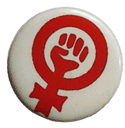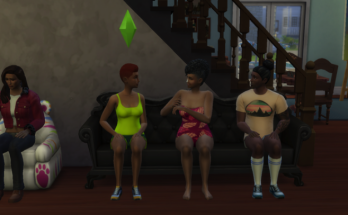Yes … ish? My students and I, from Feminist Online Spaces, created a real-space circle at Occupy LA, after some initial trepidation, but with nothing resulting other than friendly/bemused/flirty/crazy conversation from fellow Occupiers.
Why the trepidation? As we took stock of the space deciding upon our action beforehand, the presence of a group of young, collegiate-looking women brought many unanticipated (and unwanted) comments about their looks, their femaleness, and their presence in the place.
While none of the comments were threatening, per se, they did function, as is typical in such (sexist) situations, to not to make my students feel truly welcome—”welcome lovely ladies!”—but to make them feel female in a place that was overtly signalling itself as male and interested.
While it is impossible to make generalizations about everyone who is occupying LA, my experience after three visits is that this group is predominantly young and male, mixed-race, and alternatively from scenes that look like street-kids/anarchists/homeless/students/politicos/hippies. My students did not look much like them, and were told so, again and again, in a way that alternated between friendly, flirtatious, and salacious.
Now, I have been to many, many protests, big and small, public and private, since I was myself a college student, and I must attest that during this particular action (we made a small circle in the public space and held signs about feminism, patriarchy, and our bodies) I felt the least a part of the movement I was engaged with, and the most a (welcome) spectacle, as I ever have. Usually, this situation is in reverse: I feel objectification, difference, judgement from the passers-by not the protesters.
However, given the nature of the space of OLA, one demonstrates to the community and not the society at large (unless the media intervenes). My feeling was that the OLA community was supportive, and even interested, but there was little shared vocabulary by which our unique Occupy claims (Occupy Patriarchy) and our (young) female occupying bodies were readily legible within the already understood discourse and norms of the (LA) movement.
Let me put it another way. I’ve never been at a protest where being a college student (or professor) makes you stand out (or, frankly, being a feminist). I have protested against or for Apartheid, abortion, censorship, several wars, AIDS, homophobia, racism, civil rights, fraternities, violence against women, nukes, and peace.
In every one of these settings, an organized, vocal, and central presence of feminists and a feminist critique has anchored my experience, and allowed for my voice, presence, and feminist-inflected demands to feel relatively acceptable or accepted within the protest and protestors.
This is not to say that there hasn’t been internal difference or conflict (say, the role of feminists and women within AIDS organizing, for instance), but instead to suggest that within that intra-movement struggle, a strong feminist analysis became understood, by those who came to the movement with other political orientations, as fundamental to the movement.
Given that one of the strengths of the Occupy movement is that it has no fundamental point of view, but allows for anyone to use the space to make their own demands, this begs the question of whether a baseline of movement norms will ultimately be necessary for all of us in the 99% to feel welcome. I am aware of similar writing from the point of view of people of color and queers.
In my class, we have spoken about whether online spaces that allow for equal access to conversation but which then produce hostile/sexist/unthoughtful dialogues are “feminist,” and we have decided that democratic access is a necessary first step for feminist spaces, but then, so too, is feminist education, structure, and power-sharing.
I am aware that there is a Woman’s Group within OLA, and I look forward to how they will move their complex community in these directions.

